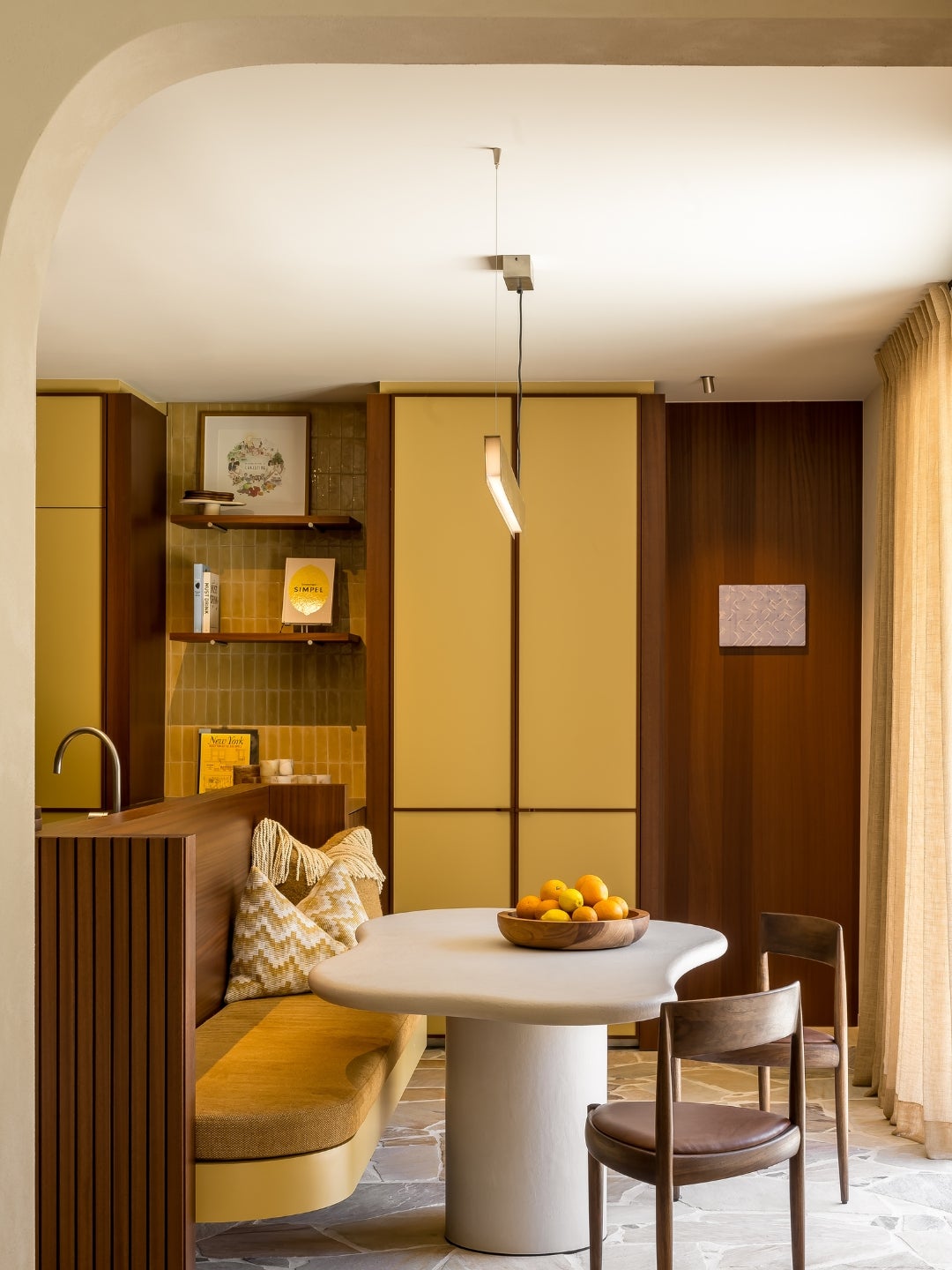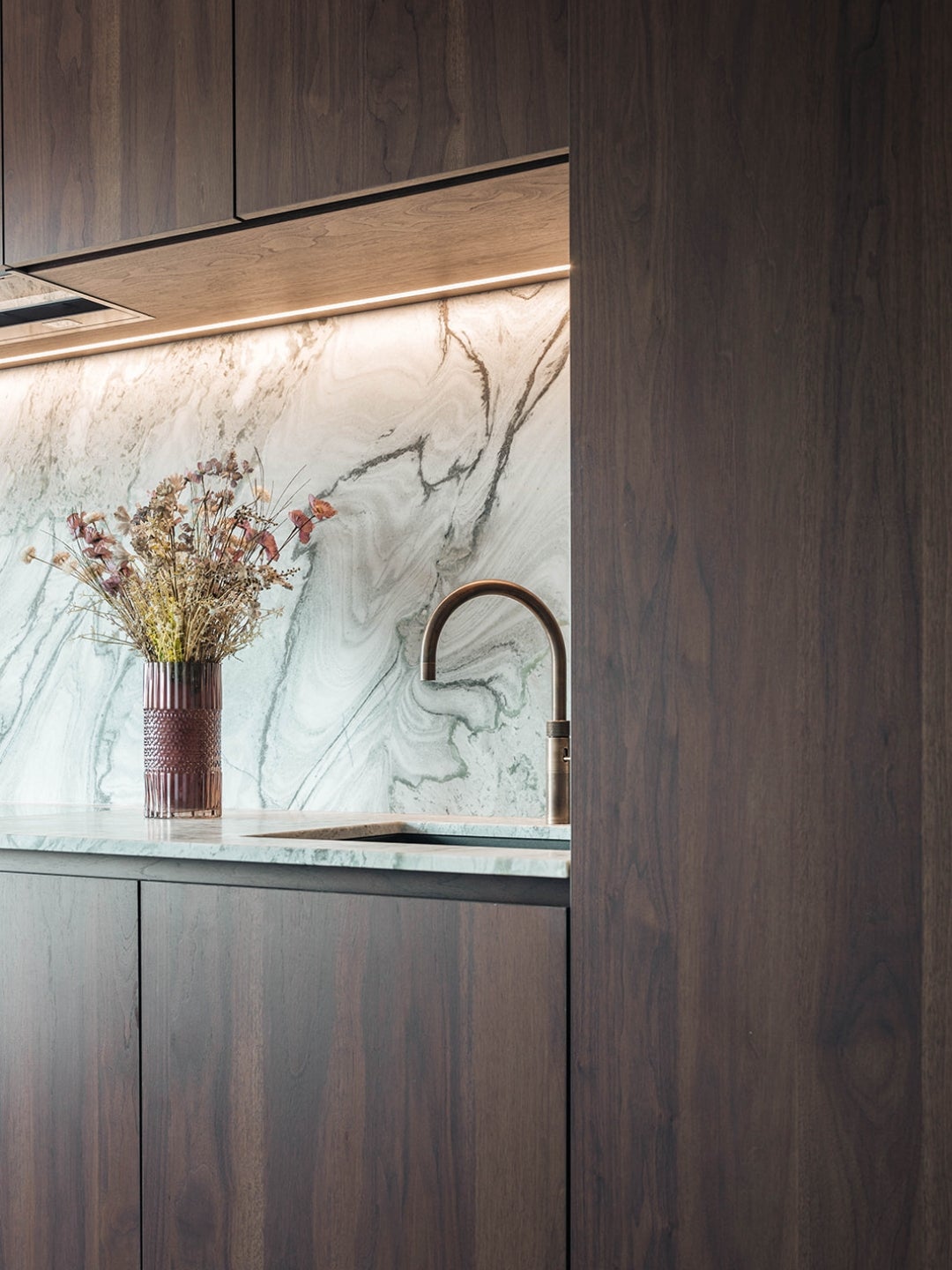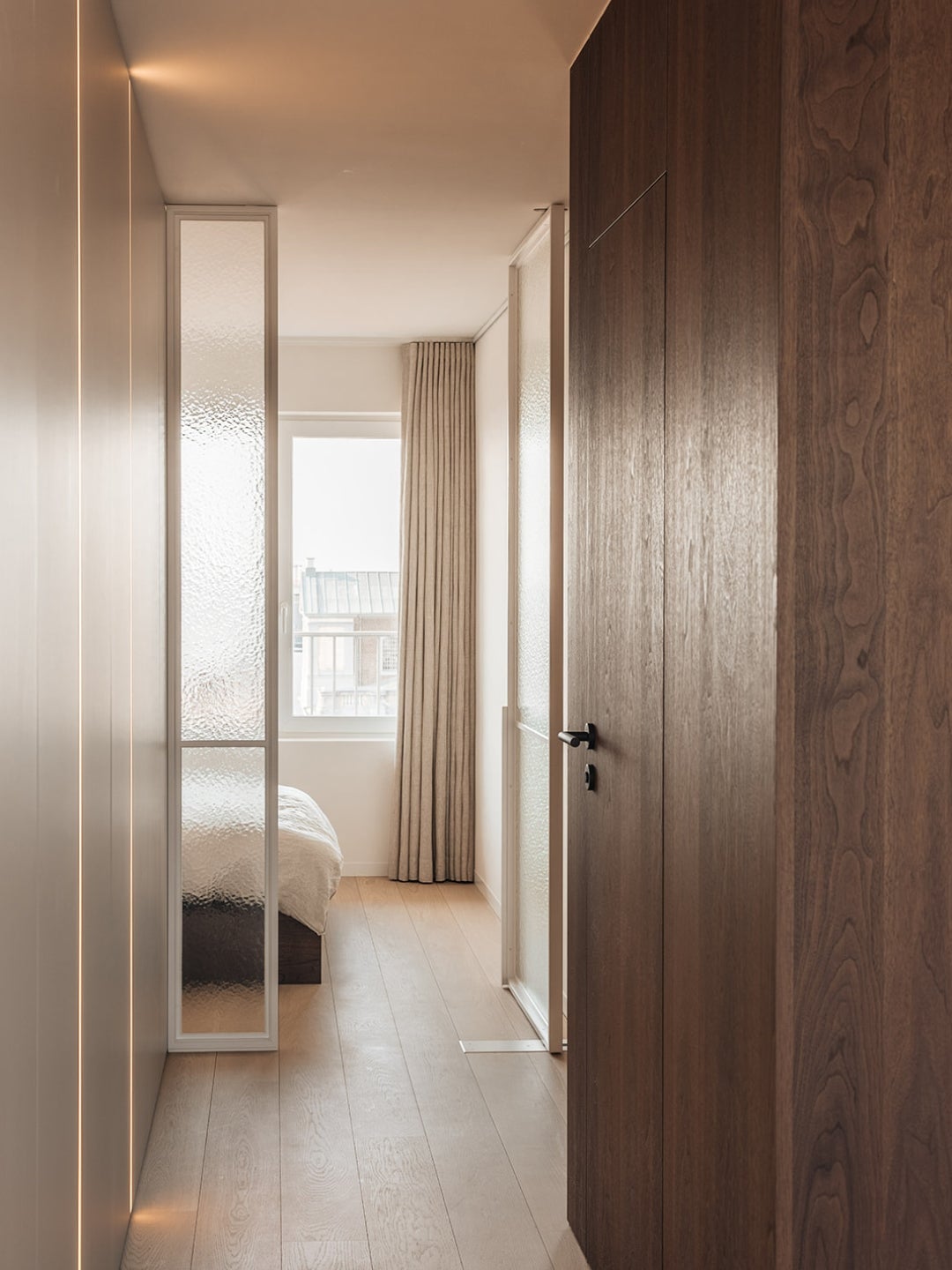Think wood.
Design is never neutral. Every surface speaks. It tells people how to move, how to feel, how long to stay. When you choose wood, you choose a material that does more than cover a wall or floor. You choose a signal of trust, calm, and character.

Science confirms what designers have sensed for decades. Studies show that wood can lower stress and improve mood in real spaces (Lipovac & Burnard, 2021; Burnard & Kutnar, 2015).
A recent neuromarketing study commissioned by Fedustria went further: brain scans revealed stronger positive emotions and reduced “danger” signals when people viewed wooden interiors (Neurensics, 2025; Fedustria, 2025). These results show a simple truth: material choices shape how people feel and behave.
Why does this matter for you?
Because every project is judged by how it feels. Offices compete for talent. Healthcare spaces fight anxiety. Homes promise refuge. When your design delivers calm and confidence, your client wins. And so do you.
Wood works because it does more than look good. It feels real. It responds to light, to touch, to time. In a corridor, it creates rhythm. In a meeting room, it sets a tone of calm authority. In a waiting area, it adds quiet strength. Every surface combines innovation and craftsmanship: precise lines, durable cores and finishes that soften glare without losing character. This is not ornament. It is structure. It is atmosphere. It is the foundation of spaces that endure.
This blog turns research into rules. It gives you clear coverage guidelines, placement strategies and Indoor Environmental Quality (IEQ) checklists. It shows how to mix materials for balance and how to measure results with simple tools. Every recommendation is grounded in evidence and shaped for practice. Because good design should feel right and prove it.
Design choices matter because they shape human experience. When we talk about wood, we move beyond aesthetics. We talk about measurable effects on stress, trust and engagement.
In 2025, Fedustria commissioned a neuromarketing study that scanned the brain’s response to different interiors.
The results were clear: wooden spaces triggered more positive emotions, higher engagement, and lower signals of danger and disgust compared to synthetic or stone environments (Neurensics, 2025; Fedustria, 2025).
Offices and healthcare settings showed the strongest gains. Homes scored high on value but low on novelty — proof that wood feels expected in residential design. Classrooms? Limited impact, mostly familiarity.
What matters here is the link between material and emotion — proof that design choices shape how people feel, often without them realising it. Still, these insights come from controlled conditions, not from the full complexity of real spaces. That’s why we combine them with broader evidence and practical guidelines.

Controlled trials and systematic reviews confirm the same direction. Lipovac & Burnard (2021) analysed multiple randomised studies and found that visual exposure to wood improves affective states and reduces physiological arousal. Burnard & Kutnar (2015) reviewed decades of work linking wood to stress reduction in built environments. These effects are modest but consistent—and they matter when aggregated across hours, days, and spaces.
Real-world evidence adds weight. Ojala et al. (2023) ran a randomised controlled trial in office settings. People working in wooden rooms reported lower anxiety after typical tasks. No miracle jumps in productivity, but a measurable lift in comfort. That’s a business advantage you can prove.
Wood also improves Indoor Environmental Quality (IEQ). Alapieti et al. (2020) show how wood supports acoustic clarity, buffers humidity and even offers antibacterial properties when detailed correctly. These are functional wins that go beyond mood.
The science is converging: wood is not just a surface. It is a tool for wellbeing. It works best when you use it with intent: right zones, right coverage, right mix. This blog translates evidence into design principles you can apply tomorrow. Because comfort is not decoration. It is precision, innovation, and trust.
Every insight in this article is backed by science and our certified products. Explore our Technical Information section for emission data, certificates and compliance details.
Too little wood and the space feels cold. Too much and it feels heavy. Research points to a sweet spot: 40–60% of the primary field of view (Li et al., 2021). That range gives warmth without visual fatigue. It creates rhythm without monotony.
Think of a meeting room. One dominant wood plane—a wall or floor—sets the tone. A secondary element, like a table, adds depth. The ceiling stays clean to keep the space light. This is not decoration. It is proportion, precision, and control.

Not every surface matters equally. People notice what they touch and what they face. That is where wood earns its keep.
- Reception desks: The first handshake of a brand. Wood signals trust and permanence.
- Meeting tables: Where decisions happen. A wooden surface softens tension and frames dialogue.
- Waiting areas: In healthcare, wood turns sterile into human. It lowers irritation and invites calm (Neurensics, 2025; Ojala et al., 2023).
- Teaching walls: In classrooms, wood adds familiarity without overwhelming the space (Li et al., 2021).
Every placement is a choice. Every choice shapes behaviour.

Wood works best in dialogue with other textures. Pair it with fabric for softness, stone for contrast and colour for clarity. Avoid flooding a space with identical tones. Variation keeps the eye engaged and the mind at ease (Kwak & Choi, 2025).
Wood-look can support a design visually, but it will never replace the sensory depth of real wood. The grain you can feel, the warmth under your hand, the way light moves across a natural surface. These are qualities no print can fully mimic.
That’s why we recommend using authentic wood where it matters most: on touchpoints, in key sightlines and in spaces where atmosphere defines experience. Wood-look has its place for durability, but real wood is what gives a project its character and credibility.

Light is one of the most powerful tools in design — and wood knows how to work with it. Unlike laminate or stone, wood interacts with light in a way that feels natural and balanced.
A matte finish doesn’t just look refined. It softens glare, reduces visual noise and creates a calm geometry that supports focus. Vertical lines do more than decorate — they guide the eye, set a rhythm and give narrow corridors a sense of movement. Horizontal lines widen a room and slow the pace, making spaces feel generous and grounded. Every grain, every line, every finish is a design decision.
Coverage, placement and mix are not abstract ideas. They are the difference between a space that looks good in a render and a space that feels right in use. They turn evidence into experience. And they give you a language of precision when clients ask, “Why wood?” Use them with intent, because these details shape how people experience your space — consciously and unconsciously.
Ready to apply these principles?
Discover our Shinnoki and Querkus collections and see how design meets precision.

Air quality: keep it clean
A space can look perfect and still feel wrong if the air is heavy with emissions. That is why every specification starts with low-emission finishes and certified boards. Choose products with documented VOC levels and keep a record of every SDS. It protects your client and your reputation (Alapieti, Mikkola, Pasanen, & Salonen, 2020).
This can be one more reason to choose for Shinnoki. The glues, stains and varnishes that we use to make Shinnoki do not contain urea formaldehyde or other harmful VOCs (volatile organic compounds), contributing to healthier indoor air quality.
Acoustics: design for clarity
Noise is stress in disguise. Wood can help you control it. Slatted panels, micro-perforations, and tuned backings turn a hard surface into an acoustic ally. Aim for a balanced RT60: enough absorption for speech clarity, enough reflection for energy. In offices, this means fewer distractions. In healthcare, it means calmer waiting rooms. In classrooms, it means voices carry without strain (Alapieti et al., 2020).
Humidity: stability you can feel
Air that swings from dry to damp makes people uncomfortable and damages materials. Wood buffers these shifts naturally. It absorbs moisture when the air is wet and releases it when the air is dry. This stabilises the microclimate and reduces stress on HVAC systems. It is a quiet function, but it matters for comfort and durability (Burnard & Kutnar, 2015).
Design for more than looks.
Access our Technical Information hub for VOC data, acoustic solutions and installation guides.
Design is not only about what you build. It is also about what you promise — and how you frame that promise. Clients trust clarity. They want to know why you chose a material, what it delivers, and what it does not.
Overstating benefits creates risk. Understating them leaves value on the table. The right words strike the balance: confident, precise, and backed by evidence.
Specification language
When you write specs, keep them active and measurable. Avoid vague terms like “natural feel” or “warm look.” Instead, define performance and intent.
Example:
Wall panels: Shinnoki Manhattan Oak veneer, matte finish, FSC-certified substrate. VOC emissions ≤ 0.05 mg/m³ (EN 717-1). Installed on acoustic backing to achieve RT60 ≤ 0.6 s in occupied condition.
This language does three things:
- Names the product and finish for clarity.
- States compliance with environmental and acoustic targets.
- Signals precision and responsibility.
Client-facing explainer
Clients do not need technical codes — they need confidence. Use language that connects design choices to human outcomes, without making medical claims.
Example:
“We use real wood on touchpoints and key surfaces because research shows it helps people feel more at ease and improves acoustic comfort. It’s part of creating a space that feels calm, natural, and trustworthy.”
This frames wood as a design strategy, not a decorative whim. It links to evidence without sounding like a lab report.
- Use verbs like supports, enhances, contributes—not guarantees.
- Anchor claims in experience and comfort, not in unverified health promises.
- Pair every benefit with a design rationale: “Wood reduces glare and softens geometry” is stronger than “Wood makes people happy.”
Design is more than form. It is a promise.
A promise that every space will feel right for the people who use it. Wood helps you keep that promise. Not because it is fashionable, but because it is functional, human and proven.
The evidence is clear: wood supports comfort, trust and calm. It improves acoustics, stabilises humidity and signals quality. But the real power of wood lies in how you apply it. With precision, proportion and purpose. That is what turns research into results.
This blog gives you the tools: coverage guidelines, placement strategies, IEQ checklists and language that builds confidence. Use them to design spaces that do more than look good. Use them to design spaces that work — physically, emotionally and commercially.
At Decospan, we believe material is never decoration. It is character, meaning and mood — the foundation of experiences that endure. When you choose wood with intent, you create more than interiors. You create environments that transform how people live, work, and connect.
Ready to take the next step?
- Alapieti, T., Mikkola, R., Pasanen, P., & Salonen, H. (2020). The influence of wooden interior materials on indoor environment: A review. European Journal of Wood and Wood Products.
- Burnard, M. D., & Kutnar, A. (2015). Wood and human stress in the built indoor environment: A review. Wood Science and Technology, 49, 969–986.
- Fedustria. (2025, 24 September). For the first time neuroscientifically shown: Our brain loves wood.
- Lipovac, D., & Burnard, M. D. (2021). Effects of visual exposure to wood on human affective states, physiological arousal and cognitive performance: A systematic review of randomised trials. Indoor and Built Environment, 30(8), 1021–1041.
- Neurensics. (2025). The Positive Impact on our State of Mind that Wood has when Used in Various Interiors [Conference presentation, commissioned by Fedustria].
- Ojala, A., Kostensalo, J., Viik, J., Matilainen, H., Wik, I., Virtanen, L., & Muilu-Mäkelä, R. (2023). Psychological and physiological effects of a wooden office room on human well-being: Results from a randomised controlled trial. Journal of Environmental Psychology, 89, 102059.
- Kwak, S., & Choi, K. (2025). Visual perceptions of wood-integrated material combinations: Effects on psychological and physiological responses. Journal of Wood Science, 71(20).
- Li, J., Wu, J., Lam, F., Zhang, C., Kang, J., & Xu, H. (2021). Effect of the degree of wood use on the visual psychological response of wooden indoor spaces. Wood Science and Technology.
- Lipovac, D., & Burnard, M. D. (2021). Effects of visual exposure to wood on human affective states, physiological arousal and cognitive performance: A systematic review of randomised trials. Indoor and Built Environment, 30(8), 1021–1041.
- Neurensics. (2025). The Positive Impact on our State of Mind that Wood has when Used in Various Interiors [Conference presentation, commissioned by Fedustria].
- Ojala, A., Kostensalo, J., Viik, J., Matilainen, H., Wik, I., Virtanen, L., & Muilu-Mäkelä, R. (2023). Psychological and physiological effects of a wooden office room on human well-being: Results from a randomised controlled trial. Journal of Environmental Psychology, 89, 102059.
- Alapieti, T., Mikkola, R., Pasanen, P., & Salonen, H. (2020). The influence of wooden interior materials on indoor environment: A review. European Journal of Wood and Wood Products.
- Burnard, M. D., & Kutnar, A. (2015). Wood and human stress in the built indoor environment: A review. Wood Science and Technology, 49, 969–986.
- Interior projects by: Line Peters Interior Design, RR interieur - Magali Six, Sylvia Ockier, Line Peters Interior Design.